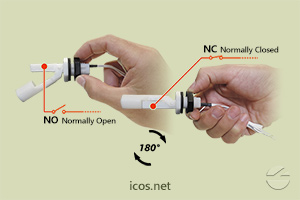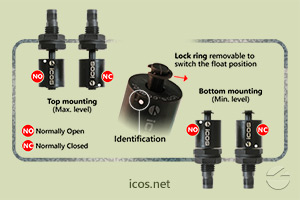What is a Level Switch?
Eicos is a manufacturer of level switches for liquids. But what is a level switch? How does it work? Where can it be used?
The level switches, also known as level sensors, are instruments that work with an electric contact (reed switch) and a magnetic float. The movement of the float opens or closes the electrical contact. With them, it is possible to have versatile low cost solutions for your automation.
How the Level Switch Works
The sensor detects the liquid level inside tanks at the point where it is installed, indicating by means of an ON/OFF signal when it reaches the level of filling, emptying or other defined in project. Because they are fixed in a point of the tank, the level switches are not influenced by ripples and vibrations, ensuring a better reliability and repeatability compared to other types of level detectors, such as the old level floats.
The sensors switch power up to 20W, enough to signal the level with a lamp or sound alarm, in systems with digital control (arduino, microcontrollers, frequency converters) or to start relays, PLC and contactors, in liquid pump activation/deactivation, for example. They are considered low power sensors and should not to be used directly to start pumps, since they work with higher power and current.
>> See how to maintain the Reed Switch electrical contact to increase the service life.
Being built in plastic, the Eicos sensor doesn't suffer from incrustations that usually occur with metals, damaging the output signal in the traditional level sensors.
Our level switches work Normally Open (NO) or Normally Closed (NC), rotating the sensor by 180° in the mounting (for side mounting sensors) or the float (for vertical sensors).

level switch - side mounting

level switch - vertical mounting
To Learn More About Our Sensors
Questions that help you choose the best sensor for your level control:
In which liquid will the sensor be applied?
We have models of sensors in various materials, with resistance to different chemical products.
What is the temperature of the application?
The constructive materials of the Eicos Level Switches can withstand temperatures from -10°C to 125°C.
Should the level control mounting be on the top, bottom, or side?
We have models for different applications with options for vertical or side mounting, inside or outside the tank.
And when the tank cannot be drilled?
We have solutions with level switches for mounting with PVC pipes, which can be introduced in the tank through the lid opening.
Do you have a large or narrow tank?
We also develop compact sensors for narrow tanks from Ø50mm, which can be applied in smaller or larger tanks.
Do you need multiple detection points?
Our side sensors can be installed in as many points as necessary for the control you want. We also produce vertical sensors with stem of 1 or 2 level detection points, having a length of up to 400mm and sensors for mounting with PVC pipes. With them, you have the practicality of deciding the number of points and length required for the application.
What is the electrical connection used?
Eicos produces sensors with options of output connection with M12 plug, DIN 43650 – B connector or wire (40cm).
Some Applications with Level Switches
The level switches have many applications and can be used for the control and automation of different areas, such as:
- Wells: for level control and pump protection;
- Civil works: in the control of the filling and emptying of cisterns and water tanks;
- Oil tanks: in oil level control systems.
See More
If you want to know more about Eicos Level Switches, visit the following pages:
